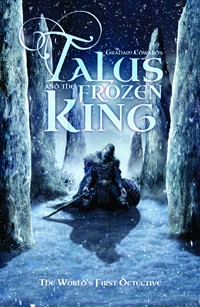
Now here’s a book that provides us with a neat spin on historical crime fiction – by setting his novel in pre-history. The Neolithic era to be precise – when the first human communities formed, early farming began and people started making the first pottery. And according to the cover we also have Talus, the first detective.
Talus is a wandering bard, moving from place to place, telling stories in exchange for food and lodgings in each village he comes to. He also has an obsessive need to find the truth of things, and an uncanny ability to pick through clues to solve mysteries and riddles. His companion is Bran, a fisherman still grieving his wife, Keyli. They met on the night Keyli died. She was caught out at sea during a meteor shower.
Talus came along as Bran was trying to pull Keyli’s boat to shore and he nearly drowned trying to help. Ultimately they were unsuccessful and upon seeing how heartbroken Bran was, Talus maked up a story to console Bran, telling him he knows of a place beyond the sea, where the Northern Lights touch the land, that is a gateway to the spirit world. He says that if Bran journeys with him, he can be re-united with Keyli forever.
When the story begins the pair have already been travelling together for two years and Bran is beginning to lose heart. The Northern Lights seem as far off as ever and Talus’s curious nature has already got them into some scrapes.
The pair come across a remote seaside community. From their place on the cliffs, the couple can hear screaming and can see all of the villagers running from their huts. Before Bran can protest, Talus has led them to the village to discover their King, Hashath, has been found dead, frozen overnight in the village square. The villagers’ grief turns to suspicion, when ever curious Talus examines the corpse and declares it murder, pointing to a hole where a sharp weapon has pieced the king’s heart.
Tharn, the king’s eldest son and heir to the throne, at first orders their deaths, but Talus bargains with him saying that he’ll find the killer. Several people present themselves as suspects. The difficulty for Talus and Bran is that all their suspects hold the power of life and death over them. Only certain people had access to Hastath. They were his six sons, his spirit guide Mishina, and a long-time rival from a neighbouring kingdom, Farrum.
The author makes the best from this setting. There is some fascinating historical detail about the period, but it never gets in the way of the story. Since there are no forensics to aid Talus’ investigation, and in the best tradition of detective fiction he likes to play his cards to his chest, I was unsure of who the murderer was right up until the moment it was revealed. But the book is more than just a whodunnit – this is a story about the power of stories, and a reflection upon the nature of friendship, love and grief.
Talus and the Frozen King is published by Solaris, a noted science fiction publisher, and together with the setting I was a little concerned about it turning into a fantasy novel, but I’m happy to say this wasn’t the case at all. The cast do think of the inexplicable in terms of the spirit world, but this seems culturally appropriate, and there are no magicians, demons or dragons.
This book is an unexpected delight, a detective story in a setting like no other, and I recommend it unreservedly.
Solaris
Print/Kindle/iBook
£5.66
CFL Rating: 5 Stars








